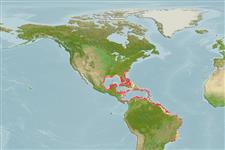Classification / Names
Common names from other countries
Main reference
Cervigón, F., R. Cipriani, W. Fischer, L. Garibaldi, M. Hendrickx, A.J. Lemus, R. Márquez, J.M. Poutiers, G. Robaina and B. Rodriguez. 1992. (Ref. 5217)
References |
Biblio |
Coordinator : Woodland, David J. |
Collaborators
Size / Weight / Age
Max length : 34.0 cm TL male/unsexed; (Ref. 9626); common length : 20.0 cm TL male/unsexed; (Ref. 5217); max. published weight: 680.00 g (Ref. 40637)
Environment
Marine; brackish; demersal
Climate / Range
Tropical, preferred ?; 37°N - 24°S, 98°W - 33°W
Distribution
IUCN Red List Status (Ref. 115185)
Threat to humans
Harmless
Human uses
Fisheries: minor commercial
More information
ReferencesAquacultureAquaculture profileStrainsGeneticsAllele frequenciesHeritabilityDiseasesProcessingMass conversion
Tools
Special reports
Download XML
Internet sources
Estimates of some properties based on models
Phylogenetic diversity index
PD50 = 0.5625 many relatives (e.g. carps) 0.5 - 2.0 few relatives (e.g. lungfishes)
Trophic Level
2.4 ±0.9 se; Based on diet studies.
Resilience
High, minimum population doubling time less than 15 months (Preliminary K or Fecundity.)
Vulnerability
Low to moderate vulnerability (26 of 100)
Price category
